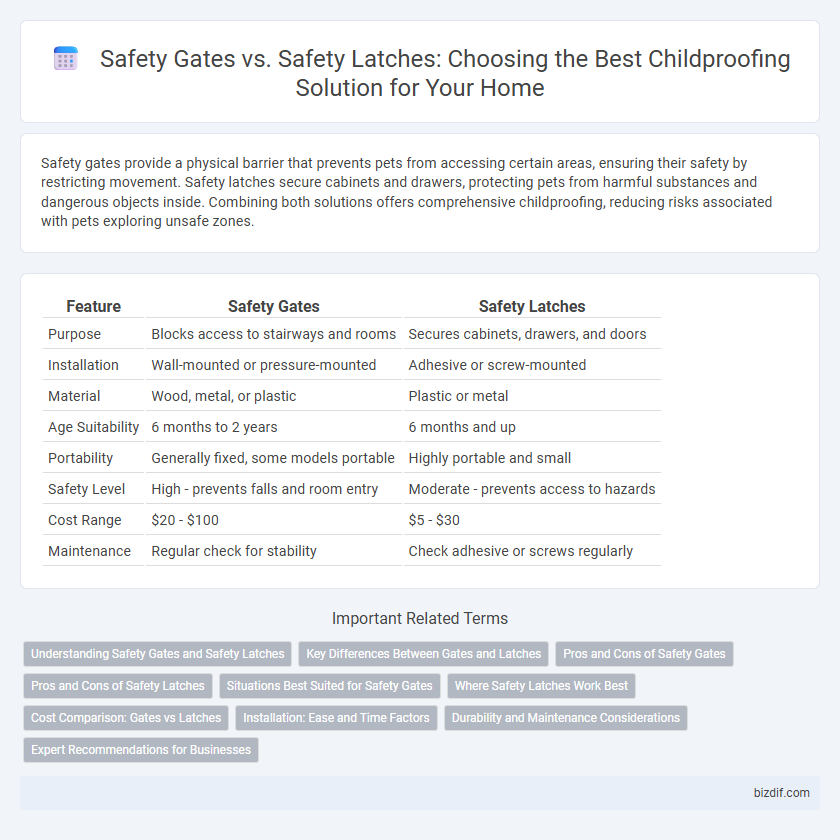Safety gates provide a physical barrier that prevents pets from accessing certain areas, ensuring their safety by restricting movement. Safety latches secure cabinets and drawers, protecting pets from harmful substances and dangerous objects inside. Combining both solutions offers comprehensive childproofing, reducing risks associated with pets exploring unsafe zones.
Table of Comparison
| Feature | Safety Gates | Safety Latches |
|---|---|---|
| Purpose | Blocks access to stairways and rooms | Secures cabinets, drawers, and doors |
| Installation | Wall-mounted or pressure-mounted | Adhesive or screw-mounted |
| Material | Wood, metal, or plastic | Plastic or metal |
| Age Suitability | 6 months to 2 years | 6 months and up |
| Portability | Generally fixed, some models portable | Highly portable and small |
| Safety Level | High - prevents falls and room entry | Moderate - prevents access to hazards |
| Cost Range | $20 - $100 | $5 - $30 |
| Maintenance | Regular check for stability | Check adhesive or screws regularly |
Understanding Safety Gates and Safety Latches
Safety gates create a physical barrier to prevent children from accessing hazardous areas like stairs, effectively reducing the risk of falls. Safety latches secure cabinets, drawers, and appliances, limiting a child's ability to reach dangerous items such as chemicals or sharp objects. Choosing between safety gates and safety latches depends on the specific hazards in the home and the areas that require childproofing.
Key Differences Between Gates and Latches
Safety gates create a physical barrier to restrict a child's access to stairs or hazardous areas, while safety latches secure cabinets and drawers to prevent opening. Gates are designed primarily for blocking off spaces, often mounted firmly to walls, whereas latches focus on keeping specific objects closed without obstructing entire pathways. Key differences include installation methods, with gates requiring more structural support and latches being easier to attach, plus their distinct uses in childproofing areas versus securing contents.
Pros and Cons of Safety Gates
Safety gates offer a robust physical barrier that effectively prevents children from accessing hazardous areas like stairs, providing a high level of security. These gates are easy to install and adjustable to different widths, but they can be challenging for adults to open quickly in emergencies. However, safety gates may pose a tripping hazard and require regular maintenance to ensure the locking mechanism remains secure.
Pros and Cons of Safety Latches
Safety latches offer a discreet solution for securing cabinets and drawers, preventing children from accessing hazardous items while maintaining aesthetic appeal. They are generally easy to install and versatile for various furniture types but may require frequent adjustment or replacement due to wear and tear. However, safety latches can be less effective on heavy cabinet doors compared to safety gates, and some models might be challenging for adults to operate quickly in emergencies.
Situations Best Suited for Safety Gates
Safety gates are ideal for blocking off entire rooms or staircases to prevent children from accessing potentially hazardous areas, making them essential for homes with open floor plans or multi-level layouts. They provide a physical barrier that is more effective in high-traffic areas where constant supervision is challenging. Safety gates are particularly suited for situations requiring the containment of toddlers in specific zones for extended periods, such as kitchens or stairways, where safety latches may not offer sufficient prevention.
Where Safety Latches Work Best
Safety latches work best on cabinets and drawers where access to potentially harmful items like cleaning supplies or sharp objects needs to be restricted. These latches are ideal for keeping curious toddlers out of kitchen or bathroom storage areas without obstructing pet access or daily use by adults. Their discreet design maintains home aesthetics while providing effective childproofing in confined spaces.
Cost Comparison: Gates vs Latches
Safety gates typically cost between $30 and $100, offering a durable and adjustable barrier suitable for various doorways and staircases. Safety latches are generally more affordable, ranging from $5 to $25 per piece, designed to secure cabinets, drawers, and appliances effectively. Choosing between gates and latches depends on the specific childproofing needs and budget constraints, with gates providing larger area protection and latches focusing on access control.
Installation: Ease and Time Factors
Safety latches typically offer quicker installation times due to their simple adhesive or screw-on design, making them ideal for busy parents seeking fast childproofing solutions. Safety gates often require more time and effort to install, involving drilling and precise measurements to ensure stability and proper fit in doorways or staircases. Choosing between safety gates and latches depends on the specific area to be secured and the desired balance between installation convenience and robust safety.
Durability and Maintenance Considerations
Safety gates offer robust durability with sturdy materials like metal or hardwood, requiring minimal maintenance beyond regular hinge lubrication and cleaning. Safety latches, often made of plastic or lightweight metal, may need more frequent inspections and replacements due to wear and tear from daily use. Choosing safety gates ensures long-term reliability for high-traffic areas, while safety latches suit smaller openings but demand attentive upkeep to maintain effectiveness.
Expert Recommendations for Businesses
Experts recommend safety gates over safety latches for businesses requiring robust childproofing solutions, as gates provide a more effective barrier preventing access to hazardous areas. Safety gates comply with industry standards such as ASTM F1004, ensuring durability and reliable performance in high-traffic environments. Choosing certified safety gates enhances liability protection and creates a safer atmosphere, crucial for childcare centers, retail stores, and hospitality venues.
Safety Gates vs Safety Latches Infographic

 bizdif.com
bizdif.com